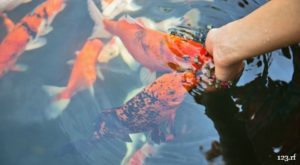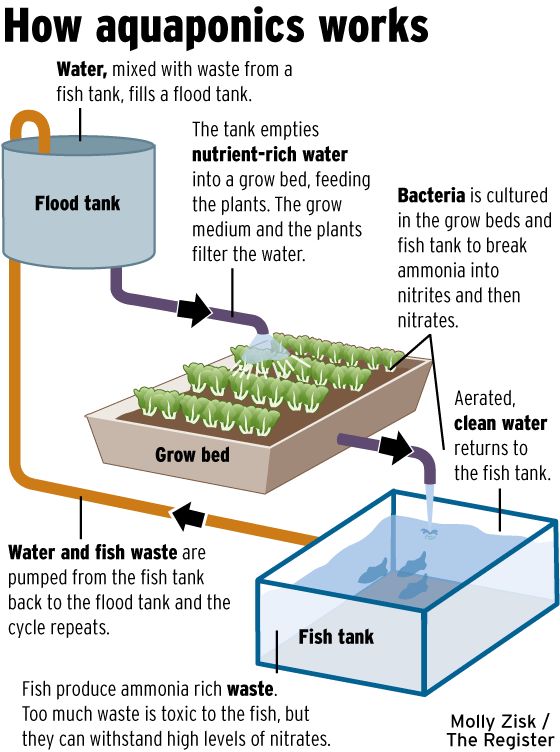
It takes much less space and resources to raise fish than it does to raise other farm animals such as cattle, so this is great for folks who don’t have the time or space to raise livestock. Growing fish in tanks is a great way to diversify your dietary choices and work toward food independence.
So Where do I Start?
Knowing where to start seems to be the most intimidating part of any project, but the answer is always the same: you start at the beginning. Start reading about fish that do well in your area. Learn how quickly they grow and how much food they require; ideally, you want one that grows fast and requires little food. Also it’s a good idea to grow fish that are resistant to disease and parasites.
Study aquaponics because it’s a great way to develop an ecosystem that provides a diverse array of foods.
Study your climate. Fish don’t particularly like to be frozen, so if you live in an area that freezes, you’re going to have to take that into consideration. Also, study the nutrition of the fish that do well in your climate and research the growth requirements for the most nutritious.
How much space do you have? How much money do you want to invest and how many of the supplies can you build or get at a decent price from local sources? As a person seeking food independence, you’ve likely already learned many great ways to score materials for free, so take advantage of that.
You can’t just buy some random fish, throw them in the pool, and call it good. Just like every other undertaking, you’re going to have to do your homework. There is no exact guidebook because everybody’s circumstances are different, but over the next several paragraphs, you’ll have some great ideas and a better feel for where to start.
What Fish are Best to Grow?
There are several fish that are particularly well-suited for indoor aquaculture, which is definitely an option. Personally, I wouldn’t want to do this in the house large-scale because of the smell, but if you have space and are only growing enough to feed a couple of people once or twice a week, it’s certainly feasible in a relatively small indoor tank.
You could also use a greenhouse if you want to have your tanks outside but live in a climate that gets moderately cold in the winter. Here are some common fish that do well in a farm environment:
- Tilapia
- Trout (cold water)
- Catfish
- Bass (be careful – they eat smaller fish)
- Carp
- Koi
- Salmon (cold water, and a great source of omega-3 fatty acids)
- Perch (cold water)
Where are You Growing Them?
Are you growing them indoors or outdoors? In tanks or in ponds? If you’re doing it in tanks, then you need to consider how many fish you can grow per tank, and how big your tanks need to be in order to support the growth of your fish.
I strongly urge you to consider aquaponics because you’re getting twice the bang for your buck, or more. You’re getting the fish, and you’re also getting produce. It’s a practical utilization of space and resources and it’s a leap toward food independence instead of a step.
Cage Culture
Ponds are great if you live in the country because you can dig them deep and the fish will grow in a more natural, less labor-intensive environment. You can use the cage culture method and can probably get it ready to go for less than a hundred bucks if you already have the pond.
You build a cage from plastic pipe and rigid netting, then put it in a pond, lake, or stream, then stock it with fingerlings and feed them until you can eat them.
Flow-Through
This method is similar to cage culture but instead of using a still body of water, you use a stream so that the water flows through it. You can grow a lot of fish in a little bit of water this way. The flowing water is always oxygenated and you don’t have to worry about cleaning the tank.
Note: Check local regulations to make sure that it’s legal to do either of the above, because it’s not in some places.
Greenhouse Aquaponics
This is the most complicated method because it involves using plants to maintain high water quality for the fish. The water is flushed through plants so that it’s re-oxygenated and the waste is filtered out of it. It’s also the most expensive to get started, but you get that cost back quickly in the form of food savings.
You’ll need tanks, a water pump and aerator, and, of course, water, fish, and plants. You can set the system up in a greenhouse or your garage, though it’s good to have sunlight.
You can grow some aquatic plants to help with the filtering and you can also build a filter using a 5-gallon bucket, so lava rocks, and a pump.
Home Recirculating
This is by far the easiest, and can be successfully done by anybody that can get an above-ground pool (size depends on your goals) and a water hose. The pools are durable and cost anywhere from $300-$1000 new (but who buys new, right?). You’ll likely need to replace the vinyl liner every few years, but that’s it.
If you want to grow more than 100 pounds of fish in a single season, a 12’x3’ pool will work as long as it’s temperature-controlled, oxygenated, and filtered. (If not, it will only grow 10-15 pounds, even with aeration). It will hold around 2000 gallons of water, even when you leave 8 inches or so at the top.
All of the species above grow well in a home recirculating system, but grow best at temperatures over 80 degrees. If you live in a climate that actually has a winter, your pool won’t reach that so you’ll need a solar dome. It’s like a giant shower cap for the pool and will keep the water warm enough to make this work.
A drum clarifier is probably the easiest way to filter all of the organic gunk from the water. You can set it up just using siphons, or you can use an air pump. The goal is to make the water flow from the pool through two 55-gallon drums that are filled with orchard netting to catch the waste. Then it flows back to the pool.
A bio-filter will remove the toxic ammonia from the water, and you need that to happen. You can make it from a piece of PVC pipe and some other items, or you can buy one. I recommend making it.
Always make sure that you have a back-up power supply because it won’t take long for the oxygen to leave the water, especially if you have several fish in there.
Now it’s time to stock your pool err … water garden with the fish that you’ve chosen from above. Non-meat-eater fish require less feed – 1 pound of pellets grows one pound of fish. The meat-eater fish will require up to 5 pounds of food to produce 1 pound of fish.
If you live in a climate that gets cold, it’s best to plan your growing season around winter in order to optimize your system. Tilapia is great for Florida and other warm climes because they really are a warm-water fish.
Once your fish are grown and you’re ready to eat, all you have to do is pull one out, clean it, and pop those delicious filets right in the pan. It doesn’t get any fresher than that!
There’s no way that I could have summed up every step from beginning to end, but I hope that this was enough information to get you started. If you have information on growing fish for food, please share it with us in the comments section below. We all benefit from shared info!
This article has been written by Theresa Crouse for Survivopedia.
from Survivopedia
Don't forget to visit the store and pick up some gear at The COR Outfitters. How prepared are you for emergencies?
#SurvivalFirestarter #SurvivalBugOutBackpack #PrepperSurvivalPack #SHTFGear #SHTFBag



No comments:
Post a Comment